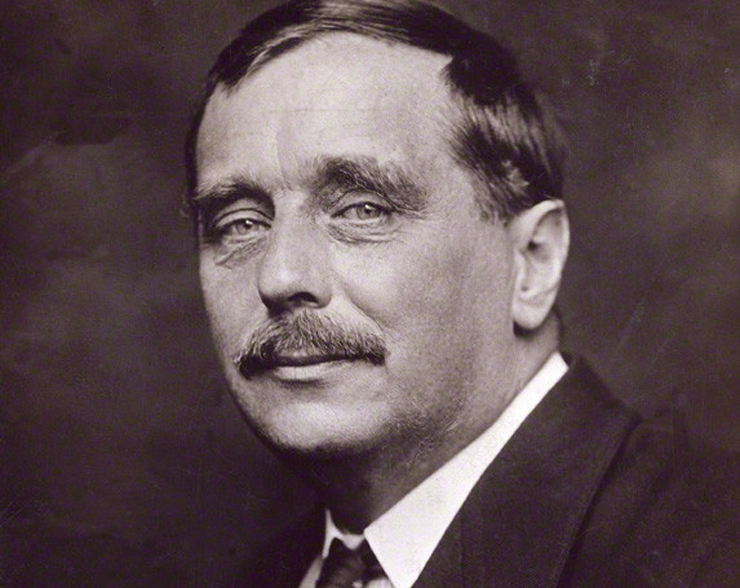 Rapprochement of Cultures.
Rapprochement of Cultures.
H.G. Wells: The Open Conspiracy for Peace.
Featured Image: Portrait of Herbert George Wells by George Charles Beresford. Black and white glossy print. 150 mm x 108 mm (1920). By George Charles Beresford, Public domain, via Wikimedia Commons.
«Behind the short-sighted governments that divide and mismanage human affairs, a real force for world unity and order exists and grows.”
H. G. Wells in A Short History of the World, 1943
Herbert George Wells, an active world citizen is usually known as just H.G. Wells. (1) From the publication of The Time Machine in 1895 to his death in 1946, Wells ‘bestrode his world like a colossus. He was a creator of modern science fiction, a pioneer of women’s rights (though he treated some badly in his many love affairs), a journalist, historian, and novelist. Above all, he was a social thinker devoted to peace and stable world order. (2)

Wells first studied biology under Thomas H. Huxley, the leading Darwinian of Victorian times, and came to see the ethical principles underlying humanity’s social systems as being rooted in the evolutionary process and therefore have the potential for onward development. Just as there was one major factor in biological progress − natural selection − so in social progress, there was one major factor − the quality of enlightened thought. As he wrote “However urgent things may seem, a great mental renascence must precede any effectual reorganization of the world.
Systematic development and a systematic application of the sciences of human relationship, of personal and group psychology, of financial and economic sciences, and of education − sciences still in their infancy − is required. Narrow and obsolete, dead and dying moral and political ideas have to be replaced by a clearer and simpler conception of the common origins and destinies of our kind.”

The Open Conspiracy.
Wells was critical of democracy as being too slow and always tending toward the middle of the road on important issues. In 1928, he tried to alert to new dangers and possibilities by proposing an “open conspiracy” − an elite group of pioneer world citizens who would organize to move humanity forward. (3). The Open Conspiracy was his organizing manual for the diverse constituencies of globally-minded citizens to bring sanity to the organizing of human affairs.
Wells clearly foresaw the need for a re-organization of the economic affairs of humanity.
“Certain things, the ocean, the air, rare wild animals must be the collective property of all humankind and cannot be altogether safe until they are so regarded and until some concrete body exists to exercise these proprietary rights…the raw material of the earth should be for all.”
Some progress has been made in the identification of endangered species, and a variety of international conventions have at least slowed the despoliation of an amount of our natural heritage. Yet the ongoing destruction of forests, over-exploitation of the oceans as well as other signs of the environmental crisis are constant reminders of how much distance is left to travel.
Wells was harshly critical of Marxist theory and of the Communist rule of Stalin in the USSR. Thus he contrasts his “open conspiracy” with the closed conspiracies and vanguard approach of Lenin whom he had met in 1920. He was also highly opposed to Fascism and its closed conspiracies. The “open conspiracy” is a project for every manner of the person once an individual has developed a ‘world consciousness’, though Wells was himself very Eurocentric in his world outlook.
He summed up his views as a race between education for world citizenship and catastrophe − a task of bold and creative minds.
Notes.
- For a detailed biography see: David Lodge A
Man of Parts (New York, Viking, 436pp.)
- For an overview of his political thinking see: John S. Partington. Building Cosmopolis: The Political thought of H.G. Wells Aldershot: Ashgate, 2003)
- The Open Conspiracy was first published in 1928 and slightly revised published in 1933. The 1933 edition is republished much more recently with a strong introduction and notes in W.Warren Wagar. The Open Conspiracy/H.G. Wells on World Revolution (Westport, CT: Praeger Publishers, 151pp.).
Rene Wadlow, President, Association of World Citizens.

Presidente, Asociación de World Citizens (AWC).
Cursó Estudios de Relaciones Internacionales en La Universidad de Chicago.
Cursó Estudios en el Programa Especial de Civilización Europea en
La Universidad de Princeton
Here are other publications that may be of interest to you.
Sorry, no posts were found.